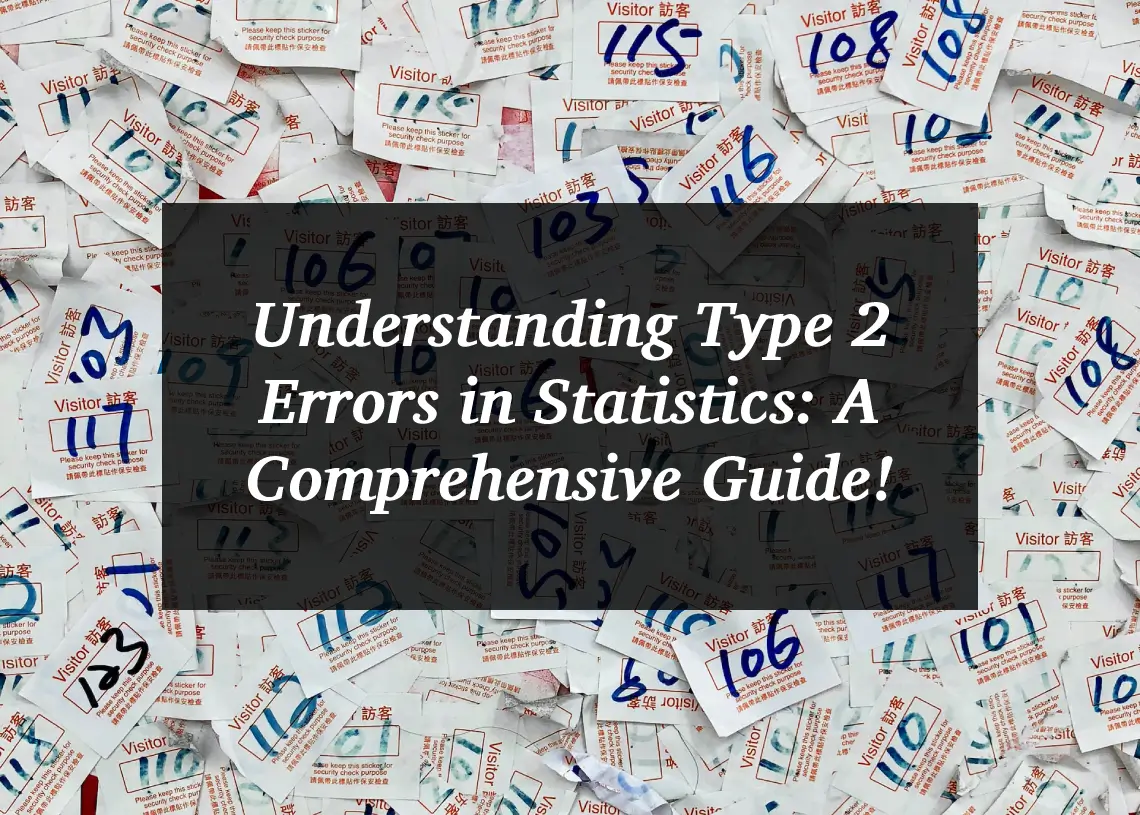Type 2 errors, also known as false negatives, are errors that occur when a statistical test fails to reject a false null hypothesis. It is one of the two types of errors that can occur in a statistical test. In this article, we will discuss what type 2 errors are, their types, causes, examples, and how to avoid them.
What is a Type 2 Error?
A type 2 error is a false negative, which occurs when a statistical test fails to reject a false null hypothesis. This means that the test incorrectly concludes that there is no difference between two sets of data when, in fact, there is a difference. It is also known as a beta error.
Type 2 errors are the opposite of type 1 errors, which occur when a statistical test incorrectly rejects a true null hypothesis. Type 1 errors are also known as alpha errors.
When performing a statistical test, it is important to understand both type 1 and type 2 errors in order to accurately interpret the results.
Types of Type 2 Errors
There are two types of type 2 errors:
- Non-discovery errors occur when a statistical test fails to reject a false null hypothesis due to insufficient sample size or insufficient power of the test.
- Misclassification errors occur when a statistical test incorrectly classifies an observation as belonging to a given group when, in fact, it does not.
Causes of Type 2 Errors
There are several factors that can cause type 2 errors:
- Insufficient sample size: A test with a small sample size is more likely to produce a false negative because the test does not have enough data to make an accurate assessment.
- Insufficient power of the test: A test with insufficient power also has a higher chance of producing a false negative because the test does not have enough power to detect a difference between two sets of data.
- Incorrectly specified null hypothesis: An incorrectly specified null hypothesis can lead to a false negative because the test is designed to reject the false null hypothesis.
- Incorrectly specified alternative hypothesis: An incorrectly specified alternative hypothesis can also lead to a false negative because the test is designed to reject the false null hypothesis.
- Multiple testing: When performing multiple tests, the probability of producing a false negative increases because the tests are more likely to reject a true null hypothesis.
Examples of Type 2 Errors
Here are some examples of type 2 errors:
- Medical testing: A doctor orders a test to determine if a patient has a certain disease, but the test incorrectly concludes that the patient does not have the disease when, in fact, the patient does have the disease.
- Product testing: A company orders a test to determine if their product meets a certain safety standard, but the test incorrectly concludes that the product does not meet the standard when, in fact, the product does meet the standard.
- Financial analysis: An analyst orders a test to determine if a company’s stock price is overvalued, but the test incorrectly concludes that the stock price is not overvalued when, in fact, it is overvalued.
- Security testing: A security team orders a test to determine if a system is vulnerable to a certain type of attack, but the test incorrectly concludes that the system is not vulnerable when, in fact, it is vulnerable.
How to Avoid Type 2 Errors
There are several steps that can be taken to reduce the probability of type 2 errors:
- Increase sample size: Increasing the sample size of a test will reduce the probability of a false negative because the test will have more data to work with.
- Increase power of the test: Increasing the power of a test will also reduce the probability of a false negative because the test will be better able to detect a difference between two sets of data.
- Specify the null hypothesis correctly: Specifying the null hypothesis correctly will ensure that the test does not reject a true null hypothesis.
- Specify the alternative hypothesis correctly: Specifying the alternative hypothesis correctly will ensure that the test does not accept a false null hypothesis.
- Reduce the number of tests: Reducing the number of tests that are performed will reduce the probability of a false negative because the tests are less likely to reject a true null hypothesis.
Common Misconceptions about Type 2 Errors
There are several common misconceptions about type 2 errors that should be addressed:
- Type 2 errors are not as serious as type 1 errors: This is false. Type 2 errors can be just as serious as type 1 errors because they can lead to incorrect conclusions being drawn from a test.
- Type 2 errors can be avoided: This is false. Type 2 errors cannot be completely avoided, but they can be reduced by taking the steps outlined above.
- Type 2 errors are only caused by sample size: This is false. Type 2 errors can be caused by a variety of factors, including sample size, power of the test, and incorrect hypotheses.
How to Calculate the Probability of Type 2 Errors
The probability of a type 2 error can be calculated using the following formula:
P(Type 2 Error) = 1 – (1 – α)^n
Where α is the probability of a type 1 error and n is the sample size.
Different Types of Statistical Tests and Type 2 Errors
Different types of statistical tests have different probabilities of producing type 2 errors. For example, tests with larger sample sizes and higher power have a lower probability of producing type 2 errors than tests with smaller sample sizes and lower power.
It is important to understand the probabilities of different test types when performing a statistical test, as this will help you interpret the results and reduce the probability of making a type 2 error.
Significance Testing and Type 2 Errors
Significance testing is a type of statistical test that is used to determine if there is a statistically significant difference between two sets of data.
When performing a significance test, it is important to understand the probability of making a type 2 error. This will help you interpret the results of the test and reduce the probability of making a false negative.
Conclusion
Type 2 errors are false negatives that occur when a statistical test fails to reject a false null hypothesis. These errors can have serious consequences and should be avoided whenever possible.
In this article, we discussed type 2 errors, their types, causes, examples, and how to avoid them. We also discussed the probability of type 2 errors and how different types of statistical tests have different probabilities of producing type 2 errors.
Understanding type 2 errors is an important part of interpreting the results of a statistical test. By taking the steps outlined in this article, you can reduce the probability of making a type 2 error and ensure that your results are accurate.


